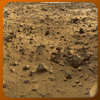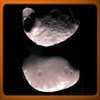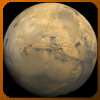You are seeing this message because you are using an out-of-date browser.
Please click here for more information.
The Red Planet
Mars, probably more than any of our solar system neighbors, has had, and continues to have, a very large impact on our social, scientific and cultural lives. Throughout history, the appearance of Mars in the sky, with its somewhat ominous red color, has been interpreted as an omen that something important, and usually bad, was about to happen.
Wars have been started, rulers have been overthrown and, in the case of the famous "War of the Worlds" broadcast in 1938, entire populations have been thrown into panic. Countless books, both fiction and non-fiction, have been written about Mars and Hollywood has churned out lots of movies, both good and bad, about what might happen when we visit Mars or when the imagined inhabitants of Mars visit us. Modern science, using information from both past and current spacecraft, paints a more fascinating picture of the Red Planet than even the movie industry has been able to dream up.
A Shining Red Light in the Sky
Mars is one of the first things people look at when they get their first telescope, and it can remain a favorite observation target for as long as they own the telescope. Mars is the only planet where the average backyard astronomer can actually see the seasons change. Amateurs using a moderately sized telescope in good viewing conditions, can actually see the polar ice caps on Mars get bigger and smaller as the planet goes through summer and winter.
If you own a telescope and would like to know whether Mars is visible during any particular month, you can check the Sky Maps section here at Astronomy for Kids. If Mars is visible, we will tell you where and when to find it.
A Frigid Desert
When early astronomers started looking at Mars through their primitive telescopes, they
could see that the planet seemed to change colors as time passed, with dark areas on
the surface of the planet growing and then shrinking as time passed. It was thought
at first that these dark areas were vegetation that grew during the Martian summer and
then died off during the winter much as some plant life does here on Earth. Also, there
appeared to be dark lines on the surface of the planet that some overenthusiastic
observers thought were canals made by intelligent life forms on the planet. All of
these "observations" just fueled the speculation, or perhaps wishful thinking, that
Mars was inhabited by intelligent life. None of these early beliefs turned out to be true.
One thing that we have learned from the various spacecraft that have visited Mars is that it is a very cold, windy, desolate place. The dark areas that were originally thought to be vegetation turned out to be nothing more than dark rock that had been blown clean by the howling winds on Mars. The planet has an average surface temperature that is below zero even during the Martian summer and there are storms on the planet that can generate clouds of dust that can hide most of the planet's surface from our view.
If humans are to ever live on the surface of the Red Planet, we will have to do so either underground or in some kind of domed areas to protect us from the extreme cold and high winds that are common on Mars. In addition, we will have to find a way to extract water and oxygen from the icy soil. There are many obstacles to overcome before Mars becomes the inhabited planet envisioned by early astronomers and science fiction writers.
Fear and Panic!
It is perhaps fitting that a planet with the ominous reputation of Mars should have two moons that are named for the horses that pulled the chariot of the Roman god of war. Phobos and Deimos are the greek words for fear and panic, respectively. The moons are very tiny and scientists now believe that they are actually captured asteroids that strayed too close to the planet and have remained in orbit ever since.
In spite of their small size, though, Phobos and Deimos have fascinating stories to tell. You can find out more about the two tiny moons by clicking on the link at right.
We're Under Attack!
Many books have been written and movies made about Earth being attacked by beings from
Mars, but the most famous of all the "Attacks from Mars" media was a radio broadcast
that took place on October 30th, 1938. On that night, Orson Welles' Mercury Theater
broadcast an adaptation of H.G. Wells' novel "War of the Worlds". In the novel, England
comes under attack by evil creatures from Mars. Orson Welles adapted the
story and broadcast it over the airwaves as if were happening live on the east coast
of the United States. The story was told on the radio by actors impersonating news reporters,
government officials and ordinary citizens. Even though listeners were told at the
beginning of the broadcast that it was just a play, many people panicked and reacted like
an attack was actually occurring. It is without a doubt the most famous and effective
example of people being unintentionally led astray by by the mass media (or maybe the
most famous example of people not paying close enough attention).
You can find out more about this famous radio broadcast and the novel that inspired it
by following the links in the "Find Out more About Mars" section.
Volcanoes and Canyons
Although most of Mars resembles nothing more than a rocky desert like you might find in the American West, there are still many features on the planet that are nothing like anything found here on Earth, or anywhere else for that matter. Valles Marineris, which is a canyon that would stretch almost from New York to California if were here on Earth is just one of those features. Another interesting fact about Mars is that it has many extinct volcanoes, the largest of these, Olympus Mons, is much larger than Mount Everest here on Earth. Olympus Mons is over 75,000 feet tall and over 350 miles wide at its base. These are just two examples of the wide variety of geographical features that make the surface of Mars a very interesting place.
Solve the Puzzle!
- Mars Page at the Nine Planets Site
- The Mars section of the Nine Planets site has more detail about the Red Planet.
- Mars Exploration Center at the Jet Propulsion Laboratory
- The Mars Exploration Center has lots of material about the red planet, including information about missions to Mars, classroom activities and much more.
- War of the Worlds Broadcast
- Find out all about the famous broadcast that threw the nation into a panic. Don't think for a minute that it couldn't happen again.
- War of the Worlds Novel
- You can read the entire H.G. Wells novel on line!
- Mars in Our Culture
- A very good reference about Mars in our popular culture from the Ames Research Center at NASA.
There is an Adobe® Acrobat® file (92k) for Mars. You can view the file online by clicking
here. You can save the file on your computer by right-clicking on the link.
You will need the free
Adobe® Acrobat® ReaderTM
to view the file.





